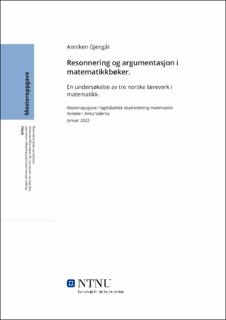| dc.contributor.advisor | Valenta, Anita | |
| dc.contributor.author | Gjengår, Anniken | |
| dc.date.accessioned | 2023-09-24T17:19:37Z | |
| dc.date.available | 2023-09-24T17:19:37Z | |
| dc.date.issued | 2023 | |
| dc.identifier | no.ntnu:inspera:138898472:101791055 | |
| dc.identifier.uri | https://hdl.handle.net/11250/3091581 | |
| dc.description.abstract | I denne studien har jeg undersøkt oppgaver og forklaringer innen geometri i læreverk som bygger på den nye læreplanen, LK20. Hensikten med studien er å få innsikt i hvilke muligheter for arbeid med resonnering og argumentasjon som legges til rette for i læreverkene. I den nye læreplanen er seks av ti kompetansemål knyttet til geometri på sjette trinn. Forskningsspørsmålet jeg stiller i denne studien er: Hvilke muligheter for arbeid med resonnering og argumentasjon finnes innen geometri i tre læreverk i matematikk for 6. trinn?
I studien har jeg benyttet mixed-methods som metode for å undersøke både frekvens og trekk ved oppgaver og forklaringer innen geometri i tre læreverk. Datamaterialet er undersøkt ved bruk av innholdsanalyse. I studien har jeg brukt et rammeverk utviklet av Otten et al. (2014). Rammeverket angir hvilke muligheter for arbeid med resonnering og argumentasjon som finnes i geometri i lærebøker.
Studien viser hvordan rammeverket kan brukes til å identifisere hvordan den nye læreplanen blir behandlet i de nye matematikkbøkene med tanke på arbeid med resonnering og argumentasjon. Resultatene fra studien viser at det finnes noen muligheter for arbeid med resonnering og argumentasjon innen geometri i lærebøker for sjette trinn. Studien viser også at størsteparten av oppgavene i lærebøkene handler om arbeid med ikke-gyldige bevis og hypoteser. Nesten ingen oppgaver ber om en spesifikk metode som skal benyttes i argumentasjon. De fleste forklaringene inneholder empirisk argumentasjon eller ingen begrunnelse for det som står.
Nøkkelord: resonnering og argumentasjon, bevis, lærebøker og læreplan. | |
| dc.description.abstract | In this study I have examined tasks and explanations within geometry in textbooks based on the new curriculum, LK20. The purpose of the study is to gain insight into what opportunities textbooks facilitate, when it comes to working with reasoning and argumentation. In the new curriculum, six out of ten competence targets are linked to geometry in the 6th grade. The research question I ask in this study is: What opportunities for working with reasoning and argumentation exist within geometry in three 6th grade mathematics textbooks?
In this study, I have used mixed-methods as a method to examine both the frequency and features of tasks and explanations within geometry in three textbooks. The data material has been examined using content analysis. In this study, I have used a framework developed by Otten et al. (2014). The framework specifies opportunities for working with reasoning and argumentation in geometry in textbooks.
The study shows how the framework can be used to identify how the new curriculum is treated in the new mathematics textbooks with regard to working with reasoning and argumentation. The results of the study show that there are some opportunities for working with reasoning and argumentation within geometry in textbooks for the 6th grade. The study also shows that most of the tasks in the textbooks provide for working with non-valid proofs and conjectures. Almost no tasks ask for a specific method to be used in argumentation. Most of the explanations contain empirical argumentation or no justification for what is stated.
Keywords: reasoning and argumentation, evidence, textbooks and curriculum. | |
| dc.language | nob | |
| dc.publisher | NTNU | |
| dc.title | Resonnering og argumentasjon i
matematikkbøker. | |
| dc.type | Master thesis | |
